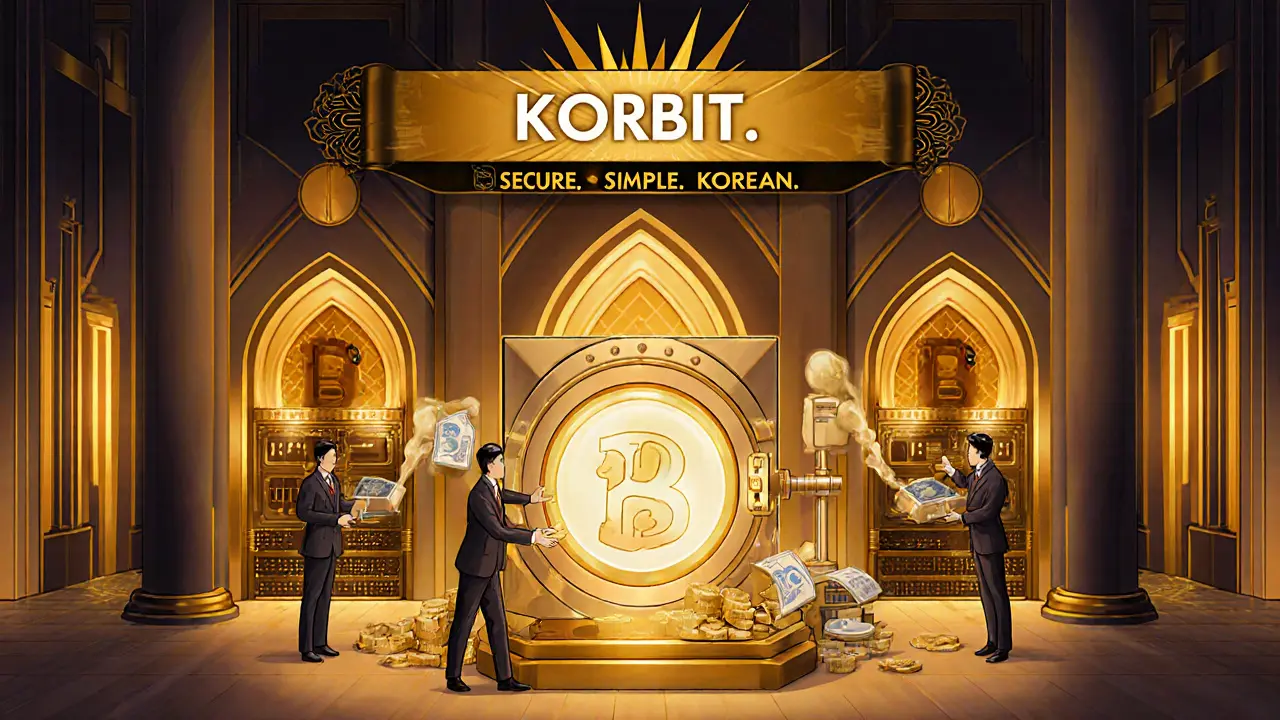Korbit Trading Fee Calculator
Calculate Your Korbit Trading Fees
See how much you'll pay in fees for your trade based on Korbit's fee structure
Important Note: Korbit offers two fee plans:
Free Plan: 0.0% for makers, 0.2% for takers
Basic Plan: 0.1% for all trades
If you're in South Korea and want to buy Bitcoin or Ethereum without jumping through hoops, Korbit might be the easiest option you’ve got. Launched in 2013 as the first Korean exchange to trade Bitcoin for Korean Won (KRW), it’s not flashy, but it’s reliable - and that matters when your money’s on the line.
Unlike global giants like Binance or Coinbase, Korbit doesn’t offer 500+ coins. It sticks to around 12 major cryptocurrencies: BTC, ETH, LTC, XRP, BCH, DASH, ZEC, XMR, and a few others. That’s not a flaw - it’s a design choice. Korbit focuses on what Korean traders actually use, not what’s trending on Reddit. This makes it simple for beginners and reduces risk from low-liquidity tokens.
How Korbit Works for Korean Users
Korbit’s biggest strength? It’s built for Korea. You can deposit KRW directly from your local bank account - no third-party payment processors, no delays. Withdrawals hit your account in under an hour during business hours. That’s something you won’t find on most international exchanges.
Setting up an account takes 24 to 48 hours because of Korea’s strict KYC rules. You’ll need your ID, proof of address, and a linked Korean bank account. If you’re not a resident, you’ll struggle. Non-Korean users often complain they can’t even complete registration. That’s not a bug - it’s compliance. Korbit follows Korea’s Financial Intelligence Unit (KoFIU) rules to the letter, which is why it’s still operating while dozens of other exchanges got shut down.
Fees and Trading Plans
Korbit offers two fee structures:
- Basic Plan: 0.1% fee on every trade - maker or taker.
- Free Plan: 0.0% for makers, 0.2% for takers.
That means if you’re placing limit orders (buying low, selling high), you can trade for free. If you’re market buying or selling instantly, you pay 0.2%. It’s a fair model - the same one used by Kraken and OKX. Minimum trade size is KRW 5,000 (about $3.50), and minimum deposit is KRW 10,000. No hidden fees. No surprise charges. You know exactly what you’re paying.
Security: One of the Best in Korea
Korbit doesn’t just claim to be secure - it’s certified. In 2018, it became the first Korean crypto exchange to earn ISO 27001, the global gold standard for information security. It also holds SOC 1 Type 2 certification, which means its financial controls are audited annually by third parties.
Over 95% of user funds are stored in cold wallets. Two-factor authentication (2FA) is mandatory. There’s no facial recognition like on some apps, but Korbit doesn’t need it. Its track record speaks for itself: no major hacks since launch. Traders Union gave it a 9.75/10 safety score - higher than most global exchanges.
Plus, Korbit is regulated by the Korean Financial Services Commission (FSC). That means if something goes wrong, you have legal recourse. Most offshore exchanges don’t offer that.

Trading Tools and Features
The platform supports limit orders, stop orders, OCO (Order Cancels the Other), and market orders. That’s enough for most traders. The interface is clean, intuitive, and available in Korean and English. If you’re new to crypto, you’ll find it easy to use.
But if you’re an advanced trader, you’ll notice the gaps. There’s no built-in charting tool like TradingView. You’ll need to open a separate browser tab. No advanced indicators, no drawing tools, no alerts. For serious technical analysis, you’ll have to use third-party tools.
Korbit also offers Ethereum staking with up to 5.2% APR. That’s competitive. It also has a small NFT marketplace and a “Piggybank” feature that lets you save small amounts of crypto daily - great for beginners who want to dollar-cost average without thinking about it.
Customer Support and User Experience
Korean users love Korbit’s speed and simplicity. On local forums, people say: “I deposit KRW at 10 AM, and it’s in my wallet by 10:15.” That’s the kind of reliability that builds trust.
But international users? They’re frustrated. Reddit threads are full of complaints: “I spent three days trying to verify my account - no reply from support.” “I can’t even log in from outside Korea.”
Support response times are slow. Emails take 2-5 business days. Live chat isn’t available 24/7. If you run into a problem and you’re not in Korea, you’re on your own. That’s the trade-off for being hyper-local.

Korbit vs. Other Exchanges
Here’s how Korbit stacks up against the competition:
| Feature | Korbit | Binance | Coinbase |
|---|---|---|---|
| Fiat Currency | KRW only | USD, EUR, GBP, and more | USD, EUR, GBP, CAD, AUD |
| Cryptocurrencies | 12 major coins | 500+ | 100+ |
| Trading Fees (Maker) | 0.0% (Free Plan) | 0.1% (standard) | 0.5% (standard) |
| Security Certifications | ISO 27001, SOC 1 Type 2 | None publicly listed | ISO 27001 |
| Regulation | Full Korean FSC compliance | Offshore, limited oversight | US-regulated |
| Mobile App | Highly rated (4.7/5 on Google Play) | Excellent | Very good |
| Best For | Korean residents | Global traders | US investors |
If you’re outside Korea, Korbit isn’t worth the hassle. But if you live there? It’s hard to beat.
Who Should Use Korbit?
Korbit is perfect for:
- Korean citizens who want to buy crypto with their local bank account
- Beginners who want a simple, secure interface
- People who value regulation over coin variety
- Those who want to stake ETH or save crypto daily
Korbit is not for:
- Non-Korean residents
- Traders who need advanced charting or 500+ coins
- People who expect 24/7 live support
The Korean crypto market is growing fast. In 2025, local exchanges handle over $10 billion in daily volume. Korbit isn’t the biggest - that’s Upbit - but it’s the most trusted. With backing from NXC, SK Square, and Nexon, it’s not going anywhere.
Final Verdict
Korbit isn’t trying to be the biggest. It’s trying to be the safest, simplest, and most reliable exchange for Koreans. And it’s winning.
Yes, the interface is basic. Yes, support is slow. Yes, you can’t trade Bitcoin for Euros. But if you’re in South Korea, none of that matters. What matters is that you can deposit KRW, buy BTC, and sleep easy knowing your money is protected by law - not just code.
For Korean users, Korbit isn’t just an exchange. It’s the default choice. For everyone else? Keep looking.
Can non-Korean users trade on Korbit?
Technically, yes - but it’s extremely difficult. Korbit requires a Korean bank account and government-issued ID to complete verification. Most international users get stuck at the KYC stage. Even if you manage to sign up, you won’t be able to deposit or withdraw fiat currency. Korbit is designed for Korean residents only.
Is Korbit safe to use?
Yes, Korbit is one of the safest crypto exchanges in South Korea. It holds ISO 27001 and SOC 1 Type 2 certifications, stores over 95% of funds in cold storage, and is fully regulated by Korea’s Financial Services Commission. There have been no major security breaches since its launch in 2013.
What cryptocurrencies can I trade on Korbit?
Korbit supports 12 major cryptocurrencies: Bitcoin (BTC), Ethereum (ETH), Bitcoin Cash (BCH), Litecoin (LTC), Ripple (XRP), Dash (DASH), Zcash (ZEC), Monero (XMR), Bitcoin Gold (BTG), Ethereum Classic (ETC), Steem, and Augur. It doesn’t offer altcoins with low liquidity or high risk.
Does Korbit offer staking?
Yes, Korbit offers Ethereum staking with an annual percentage rate (APR) of up to 5.2%. This is available until the full transition to Ethereum 2.0 is complete. Staking is simple - just deposit ETH into your Korbit wallet and enable the feature.
How long does account verification take on Korbit?
Account verification typically takes 24 to 48 hours after submitting all required documents. This includes ID verification, proof of address, and linking a Korean bank account. Delays can occur during weekends or holidays due to bank processing times.
What are Korbit’s trading fees?
Korbit offers two fee plans: the Basic Plan charges 0.1% on all trades, while the Free Plan charges 0.0% for makers (limit orders) and 0.2% for takers (market orders). There are no deposit or withdrawal fees for KRW. Crypto withdrawal fees vary by coin and are clearly listed on the platform.
Can I use Korbit on my phone?
Yes, Korbit has a mobile app available on both Google Play and the Apple App Store. The app is highly rated (4.7/5 on Google Play) and supports all core features: buying, selling, staking, and checking balances. It’s optimized for the high mobile usage rates in South Korea.




Chris Hollis
November 4, 2025 AT 23:01Korbit's only useful if you're in Korea. If you're not, don't waste your time. The KYC is a nightmare and you can't even deposit fiat. Simple as that.
Natalie Nanee
November 5, 2025 AT 10:42Why would anyone trust an exchange that locks out 99% of the world? This isn't innovation, it's isolationism disguised as compliance. They're not secure-they're just small.
gerald buddiman
November 6, 2025 AT 18:58I tried signing up from Canada… spent 3 days uploading docs, got zero replies. Then I saw the fine print: 'Korean bank account required.' I felt like I’d been pranked by a government agency.
Sunidhi Arakere
November 8, 2025 AT 07:26For Koreans, this makes sense. Local banking integration is huge. But for foreigners? It’s like trying to use a subway map from another country.
Scot Henry
November 9, 2025 AT 08:54I actually like that they keep it simple. No need for 500 coins when you’re just trying to buy BTC without getting scammed. The fees are fair, the security is solid. Why overcomplicate it?
Sierra Rustami
November 10, 2025 AT 10:39USA has Coinbase, EU has Kraken, Korea has Korbit. Why does everyone think they need to use a local exchange? You’re not special. Just use the global ones.